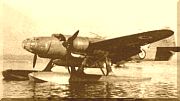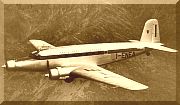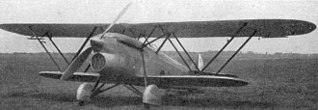
The Ambrosini SAI.3 was a two-seat Italian touring airplane first flown in 1937. It was a low-wing monoplane with a graceful, elliptical wing, and fixed tailwheel undercarriage. Customers could choose between enclosed or open cockpits, and between an inline Alfa Romeo 115 engine or a radial Fiat A.50. A revised version was marketed as the SAI.3S with a smaller-chord wing and a Siemens-Halske Sh 14 radial engine, this offering far superior performance to the original SAI.3 design.

The Fiat CR.1 was an Italian biplane fighter aircraft of the 1920s. Of wood-and-fabric construction, it was designed by Celestino Rosatelli, from whom it gained the 'CR' designation. Its most distinctive feature was that the lower wings were longer than the upper ones.
The CANSA C.6 was a training biplane developed in Italy during World War II. It was intended as an aerobatic intermediate trainer for the Regia Aeronautica and was of conventional tailskid configuration with a single-bay wing cellule with swept outer panels. Two prototypes were constructed, the single-seat C.6 and the two-seat C.6B, but no production order ensued.

The Caproni Ca.135 was an Italian medium bomber designed in Bergamo in Italy by Cesare Pallavicino. It flew for the first time in 1935, and entered service with the Peruvian Air Force in 1937, and with the Regia Aeronautica in January 1938.
The Piaggio P.32 was an Italian medium bomber of the late 1930s, produced by Piaggio, and designed by Giovanni Pegna. It was a modern design for its time, but was a failure due to lack of powerplants commensurate with its high wing loading.

The IMAM Ro.57 was an Italian twin-engined, single-seat monoplane fighter of the Regia Aeronautica. Based on a 1939 design by Giovanni Galasso the aircraft did not enter production until 1943.

The Caproni Ca.114 was a fighter biplane produced in Italy in the early 1930s which was flown operationally in Peru in the 1930s and 1940s.

The Fiat RS.14 was an Italian long-range maritime strategic reconnaissance floatplane. The RS.14 was a four/five seat all-metal cantilever low/mid-wing monoplane powered by two wing-mounted 626 kW (840 hp) Fiat A.74 R.C.38 engines. It had a conventional cantilever tail unit with a single fin and rudder. Its undercarriage consisted of two large floats on struts. It had a glazed nose for an observer or bomb aimer. The pilot and copilot sat side by side with a wireless operator's compartment behind them. In the bombing role the RS.14 was fitted with a long ventral gondola to carry various combinations of anti-submarine bombs.

The Fiat G.212 was an Italian three-engine airliner of the 1940s. An enlarged development of Fiat's earlier G.12 transport, it was used in small numbers in commercial service and by the Italian Air Force.

The Fiat CR.30 was a 1930s Italian single-seat biplane fighter aircraft designed by Celestino Rosatelli and built by Fiat.

The Nardi FN.305 was an Italian fighter trainer and liaison monoplane developed by the Fratelli Nardi company.

The Fiat AS.1 was a light touring aircraft developed in Italy in the late 1920s.

The Fiat B.R. 1/4 was a light bomber series, developed in Italy shortly after World War I.

The Fiat G.18 was an Italian airliner developed in the mid-1930s.

The Fiat G.46 was a military trainer developed in Italy shortly after World War II.

The Macchi M.24 was a flying boat designed by Alessandro Tonini and produced by Macchi in Italy during the 1920s. Originally intended as a bomber, it was eventually produced for civilian use as well.

The FiatG.91Y is an Italian ground-attack and reconnaissance aircraft which first flew in 1966. Although resembling its predecessor, the Fiat G.91, the aircraft was in fact a complete redesign, a major difference with it being equipped with twin engines rather than the original single engine.

The CANSA FC.12 was a single engine monoplane ground attack aircraft developed in Italy around 1940. A crew of two were seated in tandem. Only ten production aircraft were built.
The CANSA C.4 was a single engine, open cockpit, tandem seat training aircraft and tourer flown in Italy in 1942.

The Savoia-Marchetti SM.80 was a two-seat monoplane amphibian tourer, with a single, tractor engine mounted above the wing, designed in Italy in the early 1930s. The SM.80bis was a four-seat variant, powered by two pusher engines.

















